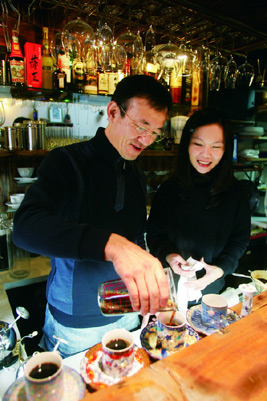Text by Xu Xiaomin
Photographs by Gao Erqiang
Less than 10 years ago, Taikang Road was a typical Shanghai lane community, full of the noise and smells of families living within whispering distance of each other. Housewives haggled over the price of live chickens at outdoor markets; men smoked cigarettes and slapped cards at courtyard tables. Neighbors shared taps, toilets and a sense of working-class struggle.
|

|
| A fine brew. |
In the intervening years, hundreds of similar communities across the city were torn down to make way for high rises and malls. The brick-lined lanes that radiate off Taikang Road almost fell victim to the same fate. But a coalition of artists, architectural preservationists and city officials fought a successful battle to reverse a decision to send in the bulldozers.
Today the Taikang Road "creative park" is booming. New galleries, cafes and boutiques are opening like clockwork, and a massive expansion program is under way to fully exploit the thousands of visitors seeking to experience the earthy atmosphere evoking old Shanghai. Residents are also cashing in on the action, in some cases moving out so they can rent their homes for substantial sums.
"Tianzifang," named after an ancient Chinese artist, seems well on its way to achieving aesthetic and commercial success. The main challenge now, however, is preventing the renaissance from destroying the community's chief charm: its eclectic mix of struggling artists and small businesses surrounded by the ebb and flow of a living community.
The lanes of Tianzifang, located in southwest Luwan District near Xujiahui Road and the North-South Elevated Highway, are chockablock with shikumen (stone-gate) houses built in the 1920s and warehouses and factories from the 1940s. The area's first act of transformation began in 1999, when world-renowned painter Chen Yifei and several other artists and fashion designers set up studios in old factory workshops on Taikang Road's Lane 210. Around 100 shops and cafes moved in after the early buzz proclaimed the area to be Shanghai's next SoHo. But development stopped a few years later after the district announced plans to tear down the old flats and warehouses to create space for a commercial real estate development.
Opposition was swift and furious. Some media outlets carried essays lamenting the loss of local culture. Among the other important voices raised against the plan, Zheng Rongfa, then administrative head of the Dapuqiao area where Taikang Road is located, lobbied his government superiors. At the end of 2004, in a rare act of art triumphing over commerce, the preservationists won. The commercial development plans were scrapped and Taikang Road's second act began.